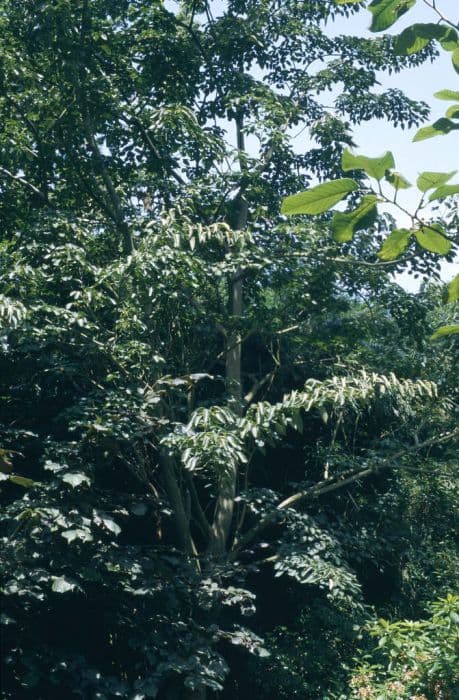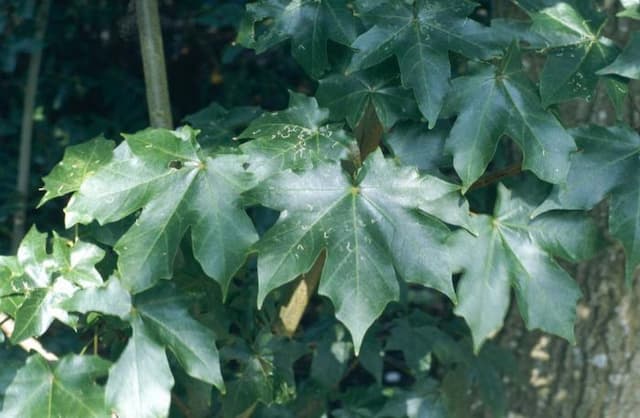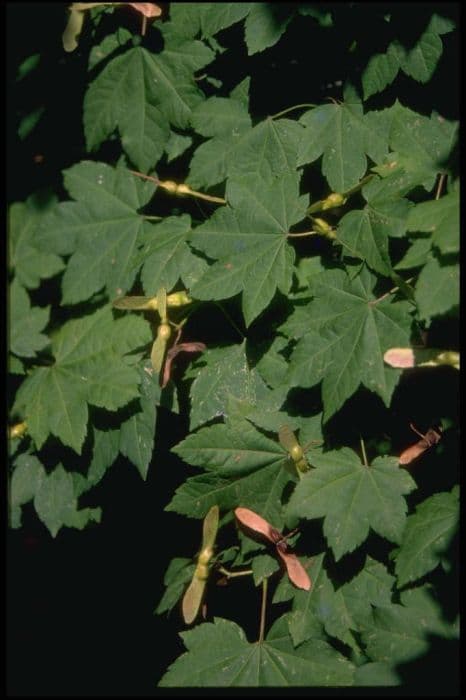Redvein Maple Acer × conspicuum 'Phoenix'

ABOUT
Acer × conspicuum 'Phoenix' is commonly known as a type of Maple. This striking plant is particularly noted for its beautiful bark and vibrant foliage. The bark peels away in strips to reveal a bright coral-red underneath, which provides a stunning contrast against the backdrop of a winter garden. During the other seasons, the bark maintains its allure with an array of colors from the reddish spectrum. This Maple's leaves are equally attractive; they emerge in the spring with a bold pink to red tint before maturing to a green color in the summer. As the seasons transition to autumn, the leaves turn again, this time to shades of yellow and occasionally orange, offering a colorful display throughout the year. The branching structure of this Maple forms a neat, patterned appearance, with its branches and twigs contributing to the ornamental value of the plant. The branch tips may retain some reddish tones that complement the striking bark. Flowers and fruit of this Maple might be less prominent, but they do exist as small, attractive features that occasionally catch the eye. The foliage of the Acer × conspicuum 'Phoenix' tends to have a strong texture, with leaves that are medium to dark green and lightly serrated along their edges. Twigs and younger branches may have a glossy look and feel owing to their smoother, fresher bark before it matures and begins its exfoliating process. This Maple has a spreading canopy that creates a graceful outline within a landscape. It's the combination of the peeling bark, colorful leaves, and elegant structure that makes it a popular choice for gardeners looking to add year-round interest to their outdoor spaces.
About this plant
 Names
NamesFamily
Sapindaceae.
Synonyms
Phoenix Maple, Redvein Maple, Snakebark Maple.
Common names
Acer × conspicuum 'Phoenix'.
 Toxicity
ToxicityTo humans
The Acer × conspicuum 'Phoenix', commonly known as Maple, is generally not considered toxic to humans. Typical maples do not present a risk when touched or ingested in small quantities. However, like many plants, it is possible that some people may have allergic reactions to certain parts of the plant, such as the sap, which contains irritating chemicals. Ingestion is not usually a cause for concern but in rare cases or when consumed in large quantities, symptoms such as stomach upset could occur. Overall, maples like the 'Phoenix' variety are not known for being poisonous to humans.
To pets
The Acer × conspicuum 'Phoenix', commonly known as Maple, is not known to be highly toxic to pets. However, some types of maples, particularly the red maple (Acer rubrum), can be toxic to horses and possibly other animals if ingested in large quantities. The toxins can cause symptoms such as abdominal pain, increased heart rate, difficulty breathing, and potentially lead to metabolic derangements like metabolic acidosis. While the 'Phoenix' maple is not specifically listed as a frequent culprit, pet owners should still be cautious and prevent pets from ingesting large amounts of any maple leaves or seeds, especially if the specific toxicity of the 'Phoenix' variety to pets is not known. If a pet does ingest a large quantity of maple leaves or seeds and shows signs of distress, a veterinarian should be consulted.
 Characteristics
CharacteristicsLife cycle
Perennials
Foliage type
Deciduous
Color of leaves
Variegated
Height
20 feet (6 meters)
Spread
15 feet (4.5 meters)
Plant type
Tree
Hardiness zones
6
Native area
Cultivar
Benefits
 General Benefits
General Benefits- Ornamental Appeal: Acer × conspicuum 'Phoenix' provides stunning visual interest with its vibrant red bark, especially during the winter months when other plants have lost their leaves.
- Shade Provider: As a deciduous tree, it offers shade in the summer, which can help reduce cooling costs and provide a cool area for relaxation.
- Habitat for Wildlife: The tree can serve as habitat and food source for various bird species, as well as insects and small mammals.
- Seasonal Interest: It has a dynamic seasonal presence with changing foliage colors ranging from green in spring and summer to yellow or red in the fall.
- Drought Tolerance: Once established, it can tolerate periods of drought, making it suitable for regions with less rainfall.
- Urban Tolerant: The tree can survive in urban conditions, withstanding pollution and confined soil spaces.
- Low Maintenance: Requires minimal pruning and care once established, which is ideal for gardeners seeking low-maintenance landscaping.
 Medical Properties
Medical PropertiesThis plant is not used for medical purposes.
 Air-purifying Qualities
Air-purifying QualitiesThis plant is not specifically known for air purifying qualities.
 Other Uses
Other Uses- Acer × conspicuum 'Phoenix' can be used in woodworking for its distinctively colored wood, which adds a unique touch to handcrafted items like bowls or picture frames.
- The stripped branches of the 'Phoenix' can be utilized in floral arrangements, especially in the winter months when its bright red bark stands out.
- Maple sap from 'Phoenix', like other maples, can potentially be tapped for syrup, albeit it may not be as sweet as syrup from Sugar Maples.
- This plant's bark can be used in crafting and textiles, providing a natural dye that imparts a gentle color to fabrics.
- Landscaping artists use the contrasting bark of 'Phoenix' as a living sculpture in oriental-themed gardens, taking advantage of its form and color in the winter landscape.
- Its leaves can be used as a natural mulch, breaking down over time to enrich the soil around other plantings in the garden.
- The plant can be incorporated into educational programs, where it serves as a specimen to study plant biology, hybrid vigor, and genetics due to its hybrid nature.
- Acer × conspicuum 'Phoenix' serves as an excellent subject for bonsai creations due to its attractive foliage and bark texture, challenging enthusiasts in shaping and care.
- Its dried leaves and small branches can be used in craft projects for children, who can create collages or imprint patterns with the textured foliage.
- Professional and amateur photographers alike use the striking appearance of 'Phoenix' maple as a backdrop or subject in natural photography, particularly in autumn and winter.
Interesting Facts
 Feng Shui
Feng ShuiThe Snakebark Maple is not used in Feng Shui practice.
 Zodiac Sign Compitability
Zodiac Sign CompitabilityThe Snakebark Maple is not used in astrology practice.
 Plant Symbolism
Plant Symbolism- Resilience: The Maple 'Phoenix' symbolizes resilience due to its ability to flourish in a variety of conditions and often represents the capacity to recover quickly from difficulties.
- Endurance: This tree's steady growth and longevity suggest endurance, reflecting the strength and stamina required to persevere over time.
- Renewal: Named after the mythical Phoenix, renowned for rising from its ashes, this Maple variety hints at rebirth and new beginnings, symbolizing transformation and a fresh start.
- Beauty: With its stunning foliage, the Maple 'Phoenix' also symbolizes beauty and majesty, exemplifying the aesthetic pleasures found in nature.
 Water
WaterThe Snakebark Maple should be watered regularly, especially during its growing season in spring and summer. Aim to keep the soil evenly moist but never soggy. Typically, watering once a week with one to two gallons of water should suffice, but this can vary depending on climate and soil drainage. During the winter, when the tree is dormant, reduce watering frequency. It's crucial to provide deep watering to encourage a strong root system, rather than just wetting the surface.
 Light
LightThe Snakebark Maple thrives in partial shade to full sun conditions. It performs best when planted in a spot where it receives morning sunlight and afternoon shade, especially in areas with hot summers. Adequate light is essential for the leaves to develop their characteristic bright coloration without getting scorched.
 Temperature
TemperatureSnakebark Maple prefers a temperate climate with temperatures ranging ideally between 60°F and 75°F. It can endure short periods of colder weather as low as 20°F and can survive in heat up to around 90°F but should be protected from extreme temperature fluctuations which can damage the tree.
 Pruning
PruningPruning the Snakebark Maple is necessary to maintain its shape, remove any dead or damaged branches, and to encourage healthy growth. The best time for pruning is in late winter or early spring before the sap starts flowing. Prune sparingly, as heavy pruning can lead to excessive sap loss. Perform structural pruning every few years to keep the tree's form.
 Cleaning
CleaningAs needed
 Soil
SoilThe Maple 'Phoenix' prefers a well-drained soil mix of loamy or sandy composition with a slightly acidic to neutral pH between 5.5 to 7.5. A mix incorporating organic matter such as compost or leaf mold can enhance soil fertility and structure, supporting healthy growth.
 Repotting
RepottingMaple 'Phoenix' trees grown in containers might need repotting every 2-3 years to prevent root-bound conditions and to replenish the nutrients in the soil.
 Humidity & Misting
Humidity & MistingMaple 'Phoenix' benefits from moderate humidity levels but is adaptable to a wide range of ambient humidity. Avoid extremely low humidity to prevent leaf scorch.
 Suitable locations
Suitable locationsIndoor
Place 'Phoenix' maple in bright, indirect light indoors, ensure good air circulation.
Outdoor
Plant 'Phoenix' maple in partial shade, shelter from harsh winds.
Hardiness zone
5-9 USDA
 Life cycle
Life cycleThe life of the 'Phoenix' Maple, Acer × conspicuum 'Phoenix', begins as a dormant seed that germinates in spring when temperatures and moisture levels are suitable. The seedling stage follows, where the young plant establishes its primary leaves and begins to photosynthesize, growing its first root system. It then enters a juvenile phase where rapid growth occurs, developing into a sapling with increased leaf and stem formation. As it matures, the 'Phoenix' Maple enters the adult phase characterized by the development of its distinctive colorful bark and the production of flowers that lead to the formation of samaras, or winged seeds. The reproductive stage continues yearly with flowering and seed production, which disperses for the next generation of maples. Finally, in its senescence stage, growth slows, and the 'Phoenix' Maple will eventually die, completing its life cycle.
 Propogation
PropogationPropogation time
Late winter-early spring
The most popular method of propagation for the Acer × conspicuum 'Phoenix', commonly known as the Striped Maple, is through softwood cuttings. This is generally done in late spring or early summer when new growth is still tender and green. Cuttings should be about 4 to 6 inches (10 to 15 centimeters) long and contain at least two sets of leaves. The lower set of leaves is removed, and the cut end of the cutting is dipped into a rooting hormone to promote root development. The treated cuttings are then placed in a well-draining soil mix and kept in a humid environment with indirect light. Maintaining high humidity can be achieved by covering the cuttings with a plastic bag or placing them in a propagation chamber. Roots typically develop within a few weeks, after which the new plants can be gradually acclimatized to less humid conditions before being planted out.




![Freeman maple [Autumn Blaze]](/_next/image?url=https%3A%2F%2Fplants-admin.emdemapps.com%2Fimages%2Fplants%2F%2Fimages%2F604b575b84d87.png&w=640&q=75)




